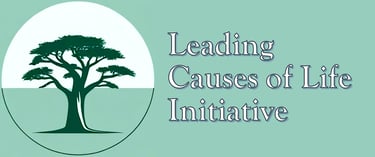With deep moral foundations, the 'leading causes of life' approach rests on five interacting elements to guide thought and action.

LCL theory
Core docs & Annotated resources
HERE ARE TWO FOUNDATIONAL DOCUMENTS
The LCL Statement (right) is a short outline of the 'leading causes of life', the mindshift it represents, and its significance.
Five 'causes of life' are identified - agency, coherence, hope, connection, intergenerativity - and some pointers given to the 'found science' - the relevant existing knowledge - behind each 'cause' (see also here for our resource package).
The 'five causes' are a parsimonious way of grasping the range of human capacities, relations, and activities that make up the complexity of personal and social life, giving us an integrated perspective on seeing and working with people and communities.
Crucially, these 'causes' may easily serve narrow, self-interested, and harmful rather than good ends. We root them, then, in a moral vision of society and the world - one where the ends that matter intend well-being for the sake of all
and the sake of the whole.
Below is the new updated, full Position Paper:
Leading Causes of Life: Integrative Idea, Different Way of Seeing
(Creative Commons licenced CC BY-NC-ND 4.0
for free but attributable sharing:)
Leading Causes of Life Statement & Position Paper
For short videos on the 'five causes' see 'About LCL' or click here.
* * *
[For LCL-linked resources (books, chapters, articles and more), see below]
Leading Causes of Life: Integrative Idea, Different Way of Seeing
[JAMA style]
Leading Causes of Life: Integrative Idea, Different Way of Seeing
[Turabian/Chicago Footnote style]
Position Paper
Leading Causes of Life
- Annotated resources
An extensive listing of key documents about the 'leading causes of life', many from those who created the theory and its approach.
Also includes a wide range of other sources - readings and other materials - on individual 'causes' (such as connection or agency) as well as more general pieces of relevant.
Fully referenced, all items are annotated to make it easier to see what you want.
NOTE: You will also find this file under 'Learning modules', linked to the many exercises that facilitators and teachers can use on the theme.


Religious Health Assets
- Annotated resources
An extensive listing of key documents on 'religious health assets', many from those who created the theory and its approach.
Also includes a wide range of other sources - readings and other materials - of relevance to understanding and working with such assets in formal and informal settings.
Fully referenced, all items are annotated to make it easier to see what you want.
NOTE: You will also find this file under 'Learning modules', linked to the many exercises that facilitators and teachers can use on the theme.


Note: You may need to 'allow cookies' to see the PDFs
[You can open it in a new window using the upper right arrow]



